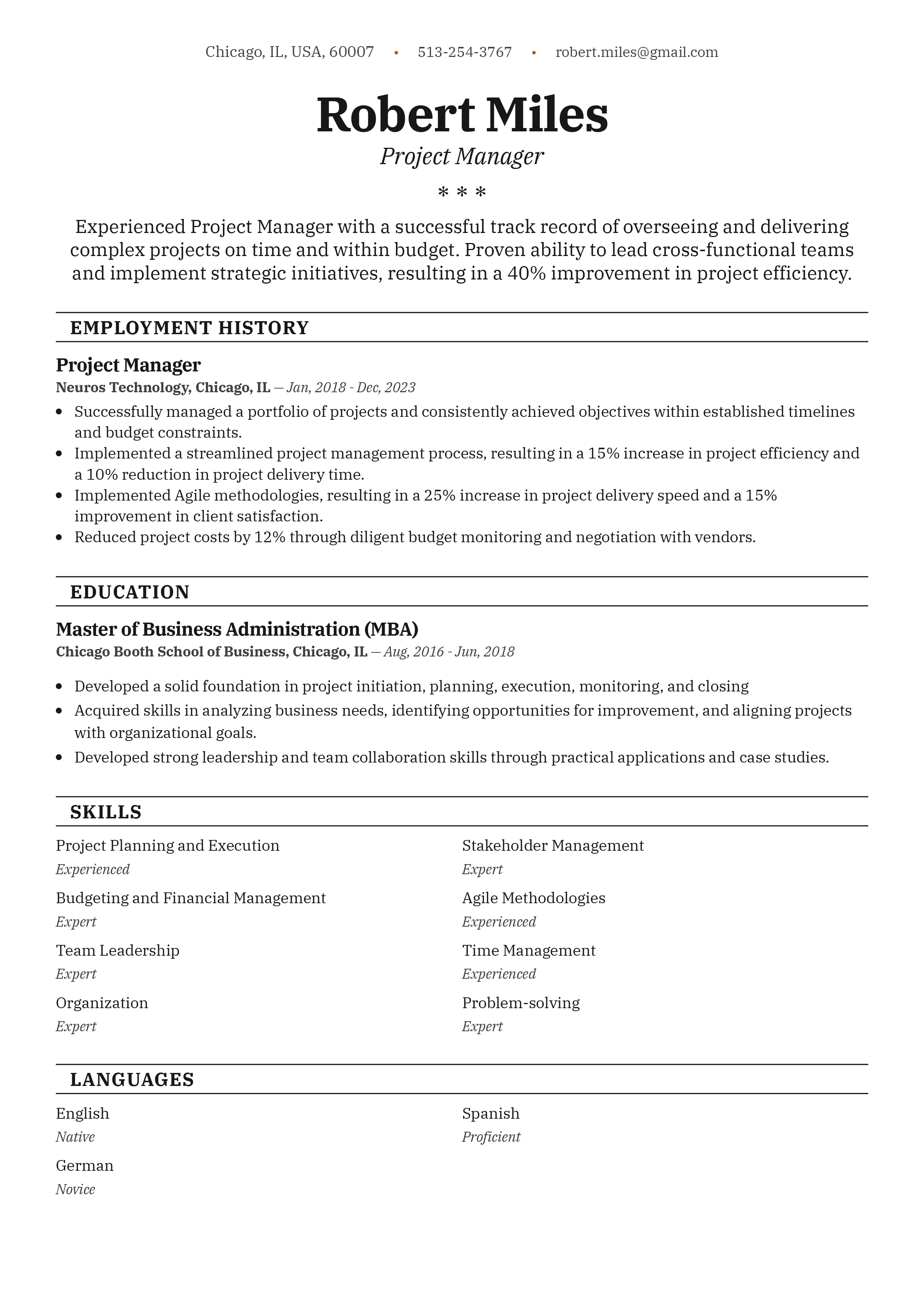In a highly competitive labor market, it’s your CV that sets you apart from other candidates with similar experience and qualifications. A recruiter decides whether to reject you or invite you to an interview within seconds. Hence, it’s no wonder why you may be asking what to include in a CV to make it stellar.
In essence, a CV serves as an account of your professional background with a single purpose—to pitch you to a prospective employer and persuade them you’re the right candidate for the job. To succeed in it, your document needs to be neat and well-organized.
Once you read our comprehensive guide, you’ll know what to include and what to leave out of your CV to make it shine. Go on reading to learn more!
Key Takeaways
A strong CV should include mandatory sections—including your contact information, professional experience, education, and skills—and optional sections—projects, awards, certifications, hobbies, and interests.
To make your CV easy to read, you need to use a professional font, pay attention to the line space and margins, and exclude colors and various design patterns.
Not everything should be listed in your CV. Information such as physical addresses, social media profiles, and irrelevant skills or experiences should always be left out.
To create a stellar curriculum vitae, use keywords to make it ATS-friendly, proofread it for typos, and personalize it to suit the position you’re applying for.
What Should Your CV Include?
Before we delve into the nuts and bolts of what to include in a CV, let’s discuss the eternal CV vs. resume dilemma.
In Europe and the larger part of the world, a CV and resume are basically the same, so you can use them interchangeably.
However, in the US and Canada, a resume refers to a summary of your work experience, unique skills, and education. A CV, however, is much longer than a resume and is used to apply for jobs in academia. As such, it focuses on your education, research and publications, conference attendance, presentations, etc., rather than professional expertise.
Thus, if you live outside of these two countries, it won’t make much difference if you submit a curriculum vitae or a resume. What matters most is what you include in it. While CV formats might vary, they all include mandatory and optional sections.
#1. Must-Have Sections
Regardless of the format, a traditional CV must include the following sections:
Mandatory CV Sections
A heading with contact information
A CV summary or objective
Professional experience
Education
Skills
#2. Nice-to-Have Sections
Though not mandatory, here are some good things to put on a CV about yourself:
Optional CV Sections
Hobbies and interests
Awards
Certifications
Languages
Training
Projects
Publications
Extracurricular activities
Volunteering experience
You don't need to bend over backward in order to list all of these sections. What you’ll include depends on several factors, the most important of which are your seniority level and the position requirements.
CV Order of Sections

Here’s what the CV order of sections should look like depending on the seniority level or the necessary highlights:
#1. Standard CV
A standard CV is best for professionals who have several years of expertise, as it focuses on the work experience and skills that are relevant to the position they are applying for.
If that’s the case with you, here’s what to include in your CV and how to order the sections:
Standard CV Sections
Contact information in the heading
CV summary
Work experience
Education
Hard and soft skills
Optional sections (hobbies and interests, certifications, awards, etc.)
#2. CV With Little/No Experience
If you were wondering how to write a CV for a job with no experience or what to put on a CV as a student, the answer lies in the sections you should include. These would be:
CV Sections with Little / No Experience
Contact information
CV objective
Education
Skills
Extracurricular activities (optional)
Projects (optional)
Volunteering experience (optional)
#3. Career Change
In case you’re changing careers, here’s how to organize the sections in your curriculum vitae:
Career Change CV Sections
Contact information
CV summary or objective
Relevant experience
Additional experience (optional)
Education
Transferable, hard, and soft skills
Optional sections (languages, certifications, awards, projects, etc.)
Formatting Tips to Make Your CV Stand Out
Crafting a solid CV isn’t only about what sections you’ll include. You should also think about how you’ll arrange them because a sleek CV enables a recruiter to find any information instantly.
To format your curriculum vitae adequately, you should pay attention to the type and size of fonts used, margins, line spacing, and overall design. These are much more important than you may think, as they directly affect the whole layout and coherence of your CV.
To format your document the right way, follow these rules:
CV Formatting Guidelines
Choose a professional-looking font and set the size to 10–12 pt.
Set one-inch margins on each side of the document.
Make headings visible by bolding and increasing the font size to 14–16 pt.
Set the line spacing at 1–1.15.
Don’t include too many colors, graphics, designs, etc., as they may make your CV messy and unintelligible.
Depending on your level of experience, you may choose between three CV formats: reverse chronological, functional, and combination.
The reverse-chronological is the most widely used format. It presents your professional and educational background in reverse-chronological order, from the latest to the oldest. It’s perfect for candidates who have rich professional expertise.
The functional format is most suitable for applicants who have little relevant experience. It allows them to focus on their skills and competencies rather than their working history.
The combination or hybrid format blends the previous two formats. It follows a similar order as a reverse chronological CV, enabling a recruiter to effortlessly track your professional background but also point out your skills and competencies.
How to Organize Your CV Sections Properly
Here’s how to arrange your CV sections to craft a stellar document:
#1. Contact Information
The first section of your curriculum vitae enables a recruiter to reach out to you. As such, it should always include:
Mandatory Contact Information
Full name and professional title
Email address and phone number
Location (city and state)
Relevant social media profiles or websites (optional)
Here’s an example:
Contact Information Section Example
Robert Miles
Project Manager
robert.miles@gmail.com
513-254-3767
Chicago, IL
linkedin.com/in/jrobert-miles
Always list a professional email and a phone number that you use actively. Don’t include emails you’ve created out of fun or a number you don’t use anymore.
Additionally, double-check everything to see if you listed all the necessary information, and make sure there are no typos. After all, how will a recruiter contact you to schedule an interview if your information is wrong?
#2. Summary/Objective
A CV summary or objective is your first chance to impress a hiring manager. Therefore, you should do your best to make them compelling. But first, you need to know the difference between the two.
A CV summary outlines your professional experience and achievements, demonstrating how you can contribute to the company’s growth. As it mostly highlights experience, it’s suitable for seasoned professionals.
A CV objective describes your career goals. It doesn’t emphasize professional achievements and expertise, so it’s best for graduates or professionals who are changing careers.
Here’s an example of a CV summary:
CV Summary Example
Experienced Project Manager with a successful track record of overseeing and delivering complex projects on time and within budget. Proven ability to lead cross-functional teams and implement strategic initiatives, resulting in a 40% improvement in project efficiency.
And this is an example of a CV objective:
CV Objective Example
Aspiring Project Manager eager to apply academic knowledge and gain hands-on experience in project management. Seeking an entry-level position to contribute to team success, develop, and learn from seasoned professionals while actively contributing to the achievement of project goals.
#3. Experience
This section gives you a chance to showcase your professional experience and achievements from previous positions. Thus, what you include here is of utmost importance, as this can be a decisive factor in whether you’ll be considered for the next stage of the hiring process.
The standard elements listed here are:
Mandatory Work Experience Information
Job title/position
Company name and location
Start and end dates of employment
Duties and achievements within the role
Here’s how to craft the experience section:
Work Experience Section Example
Project Manager
Neuros Technology, Chicago, IL
January 2018–December 2023
Successfully managed a portfolio of projects and consistently achieved objectives within established timelines and budget constraints.
Implemented a streamlined project management process, resulting in a 15% increase in project efficiency and a 10% reduction in project delivery time.
Implemented Agile methodologies, resulting in a 25% increase in project delivery speed and a 15% improvement in client satisfaction.
Reduced project costs by 12% through diligent budget monitoring and negotiation with vendors.
#4. Education
The education section of your curriculum vitae should include the following:
Mandatory Education Information
Degree and program name
The name of the educational institution where the degree was obtained
Location (city, state, or country)
Date of graduation (month and year)
If you have no professional experience, you can make this section shine by adding your academic achievements, such as your GPA, courses you attended, and honors or awards you gained.
If you didn’t attend college or university, list your high school achievements. Otherwise, there is no need to add secondary education.
Here’s how to format this section:
Education Section Example
Master of Business Administration (MBA)
Chicago Booth School of Business
August 2016–June 2018
Developed a solid foundation in project initiation, planning, execution, monitoring, and closing
Acquired skills in analyzing business needs, identifying opportunities for improvement, and aligning projects with organizational goals.
Developed strong leadership and team collaboration skills through practical applications and case studies.
#5. Skills
When you’re listing skills for your CV, you should only add those that are relevant to the position you’re applying for. Also, make sure that you add both hard and soft skills, slightly favoring the latter. If you’re changing careers, it’s recommended to add transferable skills to your CV as well.
If you’re not sure which ones to include, check out the job advertisement, look for the required skills, determine which ones you possess, and add those to your CV. Don’t forget to list them in two subsections to separate hard skills from soft ones.
Here’s an example:
Hard Skills Example
Project planning and execution
Stakeholder management
Budgeting and financial management
Agile methodologies
Risk assessment and mitigation
Soft Skills Example
Team leadership
Time management
Organization
Problem-solving
Quick decision-making
Adaptability and flexibility
Resourcefulness
#5. Optional Sections
As their name suggests, these sections are not mandatory, so you can leave them out of your curriculum vitae. Yet, listing them in your CV will allow a hiring professional to learn more about you, which may further spark their interest in you as a candidate.
Still, you need to make sure that these extra sections are relevant to the job you’re applying for.
Here’s what you can include depending on that:
Optional CV Sections
Awards and certificates. When adding these two subsections, always add the name, date of the reception, and the institution issuing them.
Languages. Always list the proficiency level; you can choose from basic, intermediate, fluent, proficient, or native.
Hobbies & interests—Choose up to five hobbies and interests and add them as a bullet list.
Training. Add the training provider, program name, and its description.
Projects, volunteering, and extracurricular activities. You should format them in the same way as the work experience section to make up for the lack of relevant professional expertise.
What Should You Avoid Including in a CV?

Not everything should be listed in your curriculum vitae; after all, it’s a summary of your (professional) biography, not your life story. Plus, you have a very limited space, so you should save it for the relevant information only.
Here’s what you shouldn’t add to your CV:
What to Exclude from Your CV
Physical address. Adding an exact address used to be popular only a few decades ago. Today, however, it’s sufficient to list the city and the state of residence.
Date of birth. Listing your date of birth may result in discrimination based on your age.
Social media profiles. If the profiles are relevant to your job, it’s perfectly acceptable to add them. Otherwise, there is no point in listing them, as it’s too personal.
Irrelevant skills and experiences. Similarly to social media, you should only add skills and experience relevant to the position you’re applying for, as it’s them that will help you stand out from other candidates.
Short-term jobs. Don’t list jobs where you spent less than a month or two, as you may give the impression you’re a job hopper.
Fluff and buzzwords. Expressions such as ‘heavy worker,’ ‘great critical thinker,’ ‘super organized,’ and ‘have exquisite time management skills’ may sound super nice on your CV, but in reality, they mean absolutely nothing.
Images. Applicant tracking systems don’t recognize images and may reject your CV instantly if you include any pictures, headshots, or graphs.
Excessive work history. If you’re a seasoned professional, you undoubtedly have a rich professional background. However, you should only list the last 10 years of your work history for two reasons: 1) save precious space; 2) recruiters aren’t interested in what you did two decades ago.
Standout CV Example

Expert Tips for Crafting a Perfect CV
The right tips and tricks make writing a CV much easier. Here’s what you should do to write a perfect curriculum vitae with no hassle and land an interview:
Tip #1. Use ATS Keywords
Recruiters rely on applicant tracking systems to prescreen candidates and reject those who aren’t fit for the position. To sift through all the candidates, an ATS uses job-specific keywords; if your CV doesn’t include them, it will be automatically rejected.
To avoid this, add keywords pertaining to your skills and qualifications from the job description to your CV to make it ATS-friendly.
Tip #2. Proofread & Update Your CV
Errors and typos in a CV can be a deal-breaker and result in rejection since a recruiter may interpret them as a sign of carelessness and a lack of attention to detail. To prevent this, always proofread your CV before submitting it. Optionally, you can ask your family and friends to do it for you.
Needless to say, your curriculum vitae should be up-to-date with your current achievements and experience. You should also update it regularly by listing the latest positions, accomplishments, and skills you’ve gained.
Tip #3. Personalize Your CV
Generic and one-size-fits-all CVs are certainly much easier to craft and submit whenever necessary. At the same time, however, they are usually a one-way ticket to rejection. Recruiters can recognize such documents instantly and will not hesitate to throw them away.
To avoid this, always tailor your CV to each job you’re applying for. You’ll not only pass the ATS, but you’ll also show the recruiter you’re willing to take an extra step to get that job. After all, if you’re motivated to craft a perfect CV, you’ll be motivated to perform your tasks as well.
Tip #4. Include Quantifiable Achievements
Listing your duties and responsibilities in the work experience sections is of no use; recruiters are well-familiar with them. What they want to see is how you can contribute to the company's growth.
A word of warning, though: don’t just list your achievements. Instead, support them with measurable figures, percentages, and facts, such as exceeding sales targets or implementing cost-saving measures.
This way, you’ll give more credibility to both your accomplishments and the entire curriculum vitae, as well as demonstrate your value as a prospective employee.
Tip #5. Use a CV Template
CV templates help you craft a stellar curriculum vitae in two ways. You can use these CV examples as a starting point or an inspiration to craft your own document; alternatively, you can use the pre-built sections and fill them out with your own content.
Either way, you will have a neat and ATS-friendly curriculum vitae that will land you an interview in a matter of days. Check out our CV templates to pick the one that resonates with you, enter your information, and we’ll have a fully personalized CV for you in no time!
And if you’re looking to strengthen your application even further, consider using a recommendation letter creator to generate professional, personalized letters of reference that complement your CV.
Final Thoughts
Every job seeker has at least once in their lifetime wondered what to include in a CV to make it perfect. Crafting this one-page document can sometimes be a true challenge, particularly when you are aware that the success of your job application depends on it.
With our guide, however, CV making will no longer be a pain but a pleasure. Plus, you’ll manage to land an interview and, hopefully, your dream job before you know it!


